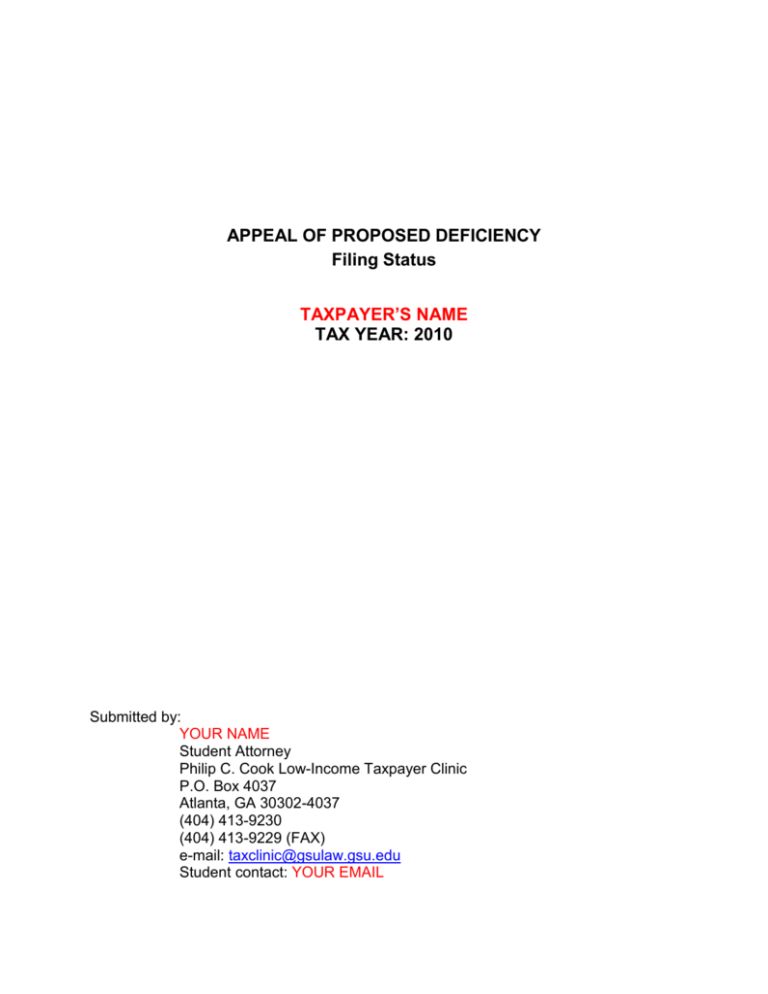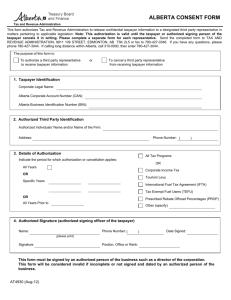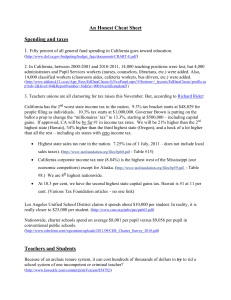Sample Filing Status Memorandum - Philip C. Cook Low
advertisement

APPEAL OF PROPOSED DEFICIENCY Filing Status TAXPAYER’S NAME TAX YEAR: 2010 Submitted by: YOUR NAME Student Attorney Philip C. Cook Low-Income Taxpayer Clinic P.O. Box 4037 Atlanta, GA 30302-4037 (404) 413-9230 (404) 413-9229 (FAX) e-mail: taxclinic@gsulaw.gsu.edu Student contact: YOUR EMAIL TABLE OF CONTENTS Relief Requested .......................................................................................... .3 Procedural Background Of Matter................................................................. .3 Statement Of Facts ....................................................................................... .4 Applicable Law .............................................................................................. 4 Application Of The Law To The Facts..............................................................6 Conclusion………………………………………………………………………….7 Exhibits A. B. C. D. E. F. G. H. I. J. K. L. 2010 Tax Return Transcript Examination Changes Statutory Notice of Deficiency Letter to IRS from Taxpayer Tax Court Petition Power of Attorney Birth Certificates of Dependent Children Social Security Cards of Taxpayer and Dependent Children Apartment Lease Correspondence Referencing Pinetree Drive Apartment Affidavit of Ms. XXX School and Medical Records of Dependent Children 2 APPEAL OF PROPOSED DEFICIENCY RELIEF REQUESTED Briefly state the Taxpayer’s name, what you are requesting the IRS to do, and the Code section(s) applicable. TAXPAYER’S NAME (“Taxpayer”) respectfully requests the Internal Revenue Service to reconsider its denial for 2010 of his Head of Household filing status and claims of three exemptions for his children, an Earned Income Tax Credit under I.R.C. § 32, and an Additional Child Tax Credit under I.R.C. § 24. Taxpayer was entitled to Head of Household filing status and to the exemptions and credits he claimed, because he satisfied all relevant requirements under the Internal Revenue Code. PROCEDURAL BACKGROUND OF TAX MATTER Include the following information in this section: Filing history of the year or years at issue Brief discussion of issues that gave rise to the liability. Discussion of the issuance of the notice or IRS correspondence that triggered this memo and who in the IRS issued it (Examination, Appeals, Collections). Include a copy Discussion of whether the client or the Clinic filed something to give rise to this memo, e.g. who filed or entered an appearance in Tax Court, the date of Counsel’s Answer, etc… and whether the Clinic entered an entry of appearance and the date of Counsel’s Answer. Discussion of where current jurisdiction lies (Appeals, Counsel or Collections or Taxpayer Advocate) and what transpired at lower level of IRS. Taxpayer timely filed a return for the year 2010 timely. (Attached as Exhibit A is a copy of Taxpayer’s 2010 Federal Individual Income Tax Return Transcript.) He filed as “Head of Household” and claimed exemptions for each of his three children, an Earned Income Tax Credit, and an Additional Child Tax Credit. The Internal Revenue Service (the “Service”) selected his return for examination. During the course of that examination, the Service disallowed Taxpayer’s Head of Household filing status, substituting “Single,” and disallowed the exemptions for the children and the two credits. (Attached as Exhibit B is a copy of the examination changes detailing the disallowances dated December 12, 2011.) Taxpayer was asked by the Service to provide documentation principally regarding his children, but was unable to provide all of such documentation in the time allowed. As a result, Taxpayer was notified on February 13, 2012, in a Statutory Notice of Deficiency, that the Service was proposing a deficiency for the year 2010 in the amount of $7,965.00 and interest of $217.61 under I.R.C. section 6601 based on the same disallowances set forth in Exhibit B. (Attached as Exhibit C is a copy of the Statutory Notice of Deficiency). Taxpayer continued to try to resolve the matter with the Service, and Taxpayer’s efforts included sending to the Service a letter explaining various matters regarding his family and their living situation. (Attached as Exhibit D is copy of that undated letter sent after Taxpayer received the Statutory Notice of Deficiency.) After attempts to resolve the 3 matter failed, Taxpayer timely filed a Petition with the United States Court. (Attached as Exhibit E is a copy of Taxpayer’s Petition). The Office of Chief Counsel filed an Answer to the petition on June 26, 2012. Subsequently, Taxpayer contacted the Philip C. Cook Low-Income Income Taxpayer Clinic (the “Clinic”) and requested our assistance. We have included a copy of the Clinic’s Power of Attorney as Exhibit F. Since Examination issued the Notice of Deficiency, settlement jurisdiction lies with Appeals. Appeals has not yet considered this case. STATEMENT OF FACTS Use this section to provide the applicable facts addressing the issue, as well as contextual information to help the IRS understand the Client’s personal and financial situation. Use exhibits to substantiate your claims, and make reference to all exhibits (e.g., “see Exhibit xx which is a ____ showing _____. Try to address the following: Who lived with the client o Evidence includes mail addressed to the individuals at the same address, school records listing the child’s address, and medical records giving the child’s residence The relationship between the client and the people in the household o Be aware that informal custody of a child may meet dependency requirements but not the EITC requirements How long any of the children lived with the client o Evidence may include school records showing a child at a specific address for the entire school year If any other person could or did claim the child as a dependent The amount and source of the client’s income The amount of financial support provided to the household by the client (i.e., did the client help with the household’s bills?) Taxpayer is a lawful permanent resident of the United States. He and Ms. XXX have three biological children: SON1, born on July --, 20--; DAUGHTER, born on November --, 20--; and SON2, born on August --, 20-- (collectively, the “Children”). (See Exhibit G for copies of the Children’s birth certificates and Exhibit H for copies of Social Security cards for Taxpayer and the Children.) Taxpayer, Ms. XXX and the Children have lived together throughout the entirety of each child’s life, including all of 2010. From January 2010 to November 2010, all five lived in an apartment on Oaktree Drive in Decatur, Georgia. (See Exhibit I for a copy of the lease.) From November 2010 through the end of that year, all five lived in an apartment on Pinetree Drive in Decatur, Georgia. (See Exhibit J for copies of various pieces of correspondence referencing the address on Fairlee Drive.) During 2010, Taxpayer was employed as a general cleaner for The Cleaning Companies, while Ms. XXX was unemployed and earned no income. Taxpayer paid all of the family’s bills, including those for the apartment rent, utilities and food. Ms. XXX’s name was on the two leases and the accounts for the utilities solely because of credit background issues experienced by Taxpayer. Ms. XXX has never claimed any of the Children as dependents on any tax return she has filed. (See Exhibit K for Ms. XXX’s affidavit attesting to the above facts relating to her.) 4 Exhibit L contains copies of certain school and medical records for the Children that are the best documentation available to Taxpayer to support his position that the Children lived with him during 2010 in the apartments described above: [1] 2009 school record for SON1 with Oaktree Drive address, [2] 2011 school record for SON1 with Pintree Drive Address, [3] letter for DAUGHTER confirming Oaktree Drive address for 2010 school year, and [4] 2011 medical record for SON2 with Pintree Drive address. Other facts of relevance to the analysis herein are: [1] none of the Children was married in 2010, [2] each of the Children in 2010 was claimed as a dependent of the Taxpayer under I.R.C. § 151 and a U.S. citizen, [3] Taxpayer was not a qualifying child of another person in 2010, [4] Taxpayer did not claim in 2010 the benefits of I.R.C. § 911 (relating to citizens or residents living abroad), [5] Taxpayer had earned income in 2010, [6] Taxpayer was a U.S. citizen for all of 2010, [7] Taxpayer did not file as “Married Filing Separately” in 2010, and [8] Taxpayer’s investment income in 2010 did not exceed $2,200. APPLICABLE LAW Under this section don’t put facts, only law. The section should begin with statutory references, then cases, then regulations, then other authority. Remove any portion of this section that does not apply to your client’s case. Head of Household: I.R.C. § 2 defines “Head of Household.” Pursuant to I.R.C. § 2(b), a taxpayer is entitled to Head of Household filing status if he [1] is not married at the close of the taxable year, and [2] paid more than half the cost of maintaining a home that was his principal home and the principal place of abode for more than one-half of the taxable year for any of the following: [a] A qualifying child of the taxpayer as defined in I.R.C. § 152(c) (discussed below and determined without regard to I.R.C. § 152(e)), provided the child is not both [a] married and [b] an individual who satisfies other requirements in I.R.C. § 2(b)(1)(A)(i). [b] Any other relative of the taxpayer eligible to be claimed as a dependent under §152, except those eligible to be claimed under a multiple support agreement. Child Tax Credit: I.R.C. § 24 generally provides a $1000 tax credit with respect to each qualifying child of the taxpayer for which the taxpayer is allowed a deduction under I.R.C. § 151 (discussed below). For purposes of I.R.C. § 24, the term “qualifying child” means a child who [1] has not attained the age of 17, [2] is a qualifying child of the taxpayer as defined in I.R.C. § 152(c) (discussed below), [3] is properly claimed as a dependent under I.R.C. § 151, and [4] is a U.S. citizen, resident or national. 5 Under I.R.C. § 24(d), if the amount of the child tax credit exceeds the amount of tax owed, a certain portion of the may be refundable (referred to as the “Additional Child Tax Credit”). Earned Income Tax Credit: I.R.C. § 32 provides than an eligible individual may take an Earned Income Tax Credit (“EITC”) against his or her earned income for the taxable year. An eligible individual includes “any individual who has a qualifying child for the taxable year.” For purposes of I.R.C. § 32, the term “qualifying child” includes an unmarried qualifying child of the taxpayer as defined in I.R.C. § 152(c) (discussed below and determined without regard to I.R.C. § 152(c)(1)(D) and (e)), provided [1] the taxpayer includes the name, age and TIN of the child on the tax return for the relevant taxable year, and [2] the joint principal place of abode for the taxpayer and qualifying child for more than one-half of the year is in the United States. I.R.C. § 32 precludes a taxpayer from claiming the EITC if the individual does not include his valid social security number on his income tax return and, if married, the valid social security number of his spouse. A valid social security number is one that allows the taxpayer to work. I.R.C. § 32 precludes a taxpayer from claiming the EITC if he is a qualifying child of another person. I.R.C. § 32 precludes a taxpayer from claiming the EITC if the taxpayer claims the benefits of I.R.C. § 911 (relating to citizens or residents living abroad) for the taxable year. I.R.C. § 32 further stipulates that a taxpayer must have earned income during the year for which he claims the EITC and must be a U.S. citizen or resident alien the entire year for which he claims the EITC. Finally, I.R.C. § 32 precludes a taxpayer from claiming the EITC if the individual’s filing status is “Married Filing Separately,” or the individual’s investment income for the taxable year exceeds $2200. Exemptions for Dependents: I.R.C. § 151 allows a taxpayer an exemption for each individual who is a dependent as defined in I.R.C. § 152. Any such exemption shall be allowed as a deduction to the taxpayer in computing taxable income. I.R.C. § 152 provides that the term “dependent” includes a qualifying child as defined in I.R.C. § 152(c). To be considered a qualifying child under I.R.C. § 152(c), an individual must [1] be a child of the taxpayer or bear a certain other type of relationship to the taxpayer, [2] have the same principal place of abode as the taxpayer for more than one-half of the taxable year, [3] be under the age of 19 or, if a student, the age of 24, [4] not have provided over one-half of the individual’s own support for the taxable year, and [5] not have filed a joint return with the individual’s spouse for the taxable year. I.R.C. § 152(c)(4) provides special rules in cases in which an individual is a qualifying child of more than one taxpayer. 6 APPLICATION OF THE LAW TO THE FACTS New facts should not be mentioned. All facts must be set forth in the facts section. Do not simply provide conclusions. Give a brief discussion of how the client’s facts relate to the requirements of the law. As discussed above, each of the issues in this matter require an examination of whether in 2010 the Children were qualifying children of Taxpayer as defined in I.R.C. § 152(c). Each of the Children satisfied all of the requirements for qualifying child status because, as shown in the Statement of Facts and corresponding Exhibits, each of the Children was in 2010 an individual who [1] was a child of Taxpayer, [2] had the same principal place of abode as Taxpayer for more than one-half of the taxable year, [3] was under the age of 19, [4] did not provide over one-half of such individual’s own support for the taxable year, and [5] did file a joint return with such individual’s spouse for the taxable year. Note also that the special rules of I.R.C. § 152(e) relating to children of divorced parents do not apply to the Children. Taxpayer is entitled to Head of Household filing status under I.R.C. § 2 because, as shown in the Statement of Facts and corresponding Exhibits and discussed above, Taxpayer (i) was not married at the close of 2010, and (ii) for 2010 paid more than half the cost of maintaining a home that was his principal home and the principal place of abode for more than one-half of 2010 for each of the Children, each of whom for 2010 was a qualifying child as defined in I.R.C. § 152(c) (determined without regard to I.R.C. § 152(e)). Taxpayer is entitled to a child tax credit under I.R.C. § 24 with respect to each of the Children because, as shown in the Statement of Facts and corresponding Exhibits and discussed above, in 2010 each of the Children [1] had not attained the age of 17 by the close of 2010, [2] was a qualifying child of Taxpayer as defined in I.R.C. § 152(c), [3] was properly claimed as a dependent of Taxpayer in 2010, and [4] was a U.S. citizen, resident or national. Taxpayer is entitled to the EITC under I.R.C. § 32 because, as shown in the Statement of Facts and corresponding Exhibits and discussed above, [1] each of the Children was a qualifying child in 2010 as defined in I.R.C. § 152(c), [2] each of the Children had his or her name, age, and TIN included on Taxpayer’s 2010 tax return, and [3] the joint principal place of abode of the Taxpayer and the Children was in the United States (i.e., Decatur, Georgia). Taxpayer is not precluded from claiming the EITC under any of the limitations set forth in I.R.C. § 32 and discussed above. Specifically and as shown in the Statement of Facts and corresponding Exhibits, Taxpayer [1] included his valid social security number on his 2010 income tax return and was not required to include the social security number any spouse, [2] was not the qualifying child of another person in 2010, [3] did not claim the benefits of I.R.C. § 911 in 2010, [4] had earned income during 2010 the EITC, [5] was a U.S. citizen for all of 2010, [6] did not file as “Married Filing Separately” in 2010, and [7] did not have investment income in 2010 exceeding $2200. 7 Taxpayer is entitled to claim an exemption under I.R.C. § 151 for each of the Children in 2010 because, as shown in the Statement of Facts and corresponding Exhibits and discussed above, each of the Children was in 2010 a qualifying child of Taxpayer as defined in I.R.C. § 152(c). Furthermore, the special rules of I.R.C. § 152(c)(4) do not apply because Taxpayer was the only taxpayer eligible to claim each of the Children as a qualifying child in 2010, given that Ms. XXX earned no income in 2010 and did not claim any of the Children as a qualifying child in 2010. CONCLUSION Taxpayer respectfully submits that for 2010 he is entitled to Head of Household filing status and to claim three exemptions for the Children, an Earned Income tax Credit and an Additional Child Credit. 8






